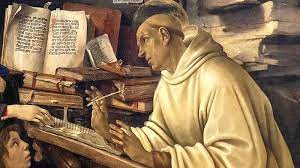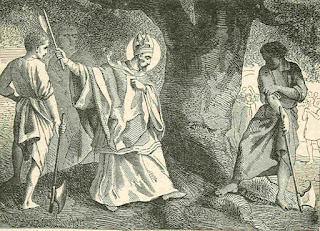Innocent fled to France and the protection (with the convincing of Bernard of Clairvaux) of King Louis VI. He later secured, with the help of Bernard, the support of King Lothair III of Germany (whom he later crowned Holy Roman Emperor). Bernard had written to Lothair, emphasizing the fact that Anacletus' great-great-grandfather was a converted Jew, saying "It is a disgrace for Christ that a Jew sits on the throne of St. Peter's." Innocent also met Henry I of England at Chartres in January 1131 and received his support.
Louis convened a council of French bishops and asked Bernard to make a judgment about the legitimacy of the two popes. Bernard declared Innocent the pope and Anacletus an antipope. Bernard then traveled to Italy to persuade others to accept Innocent. His rhetorical skill convinced Milan to support Innocent. He also reconciled Pisa and Genoa, who had engaged in a trade rivalry for generations, establishing separate Pisan and Genoese areas of maritime influence.
Bernard also went to Aquitaine and spoke to Duke William X, eventually shifting his support from Anacletus to Innocent in 1135.
Despite all of Bernard's efforts on behalf of Innocent, and Lothair's military attempts to depose Anecletus, the papal conflict was not resolved except by the death of Anacletus in 1138. A supporter of Anacletus, Gregorio Conti, was elected Pope Victor IV, but Bernard stepped in once again. Over the course of two months, Bernard convinced Gregorio of the inappropriateness of his papal post, and he was convinced to submit to the authority of Innocent. "Victor IV" became another antipope. Innocent restored his status as cardinal.
After all that, Bernard retired to Clairvaux and devoted himself to writing the theological works that earned him the title "Doctor of the Church." He was called upon to help resolve further conflicts and battle heresy with his rhetorical gifts, and he preached the unsuccessful Second Crusade, giving what has been called "the speech of his life."
He was involved in a great many political and religious conflicts (some of which he might have caused himself) before his death on 20 August 1153. His life was so full of accomplishment that he will no doubt be mentioned in further posts. Presently, however, I want to stick with Innocent II, who convened the Second Lateran Council. It dealt with many topics, and also showed that Innocent's gracious treatment of his rival Victor was a sham.
And that's a story for another day.



























